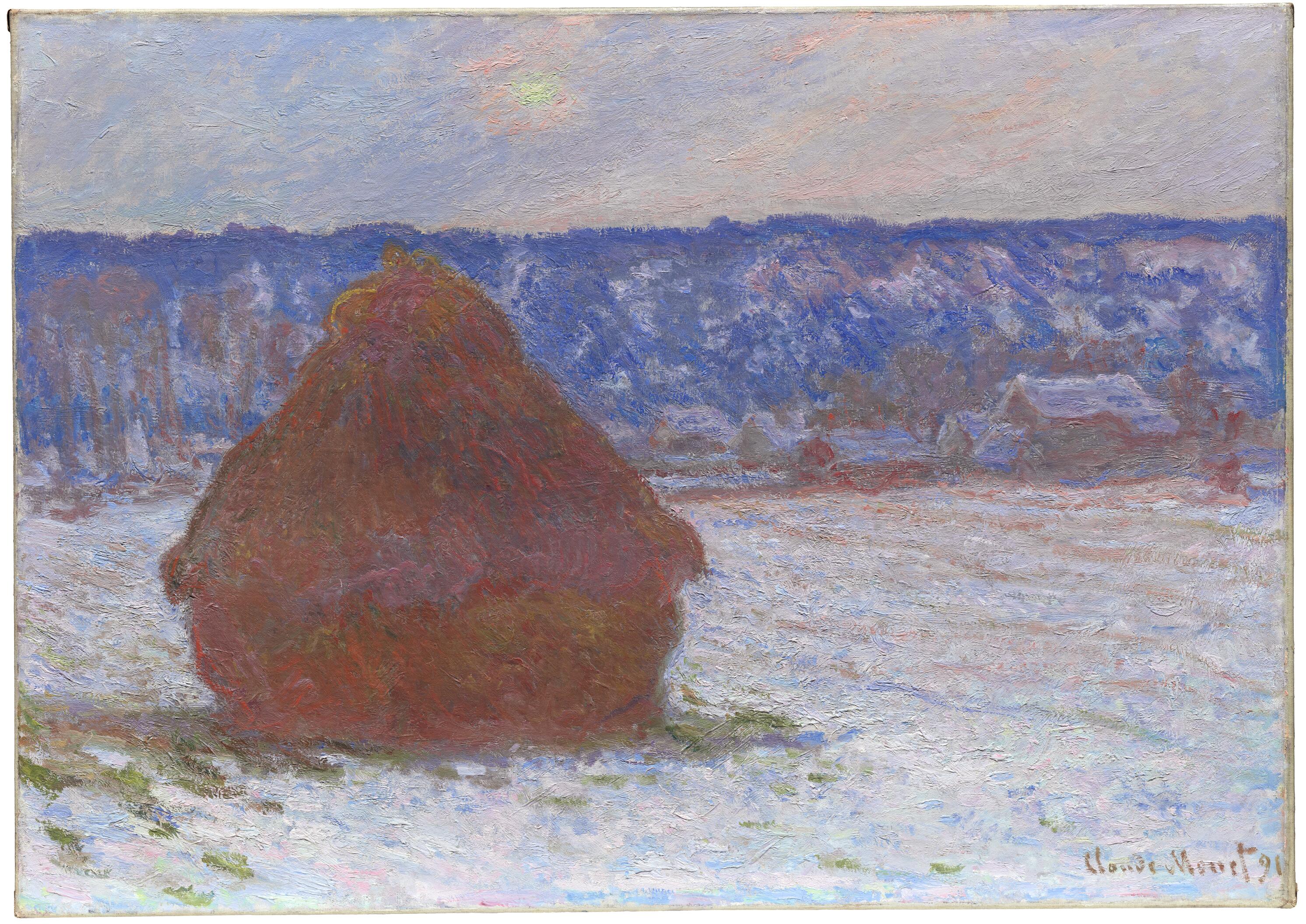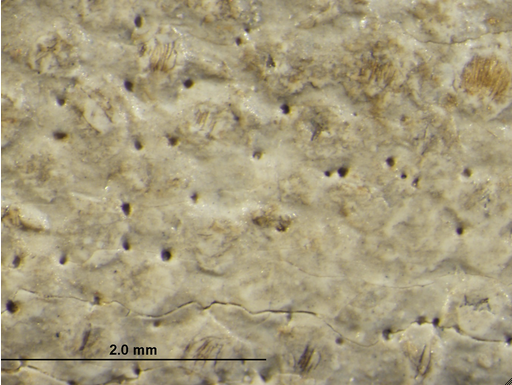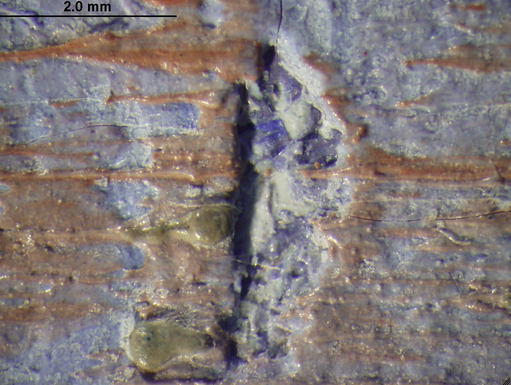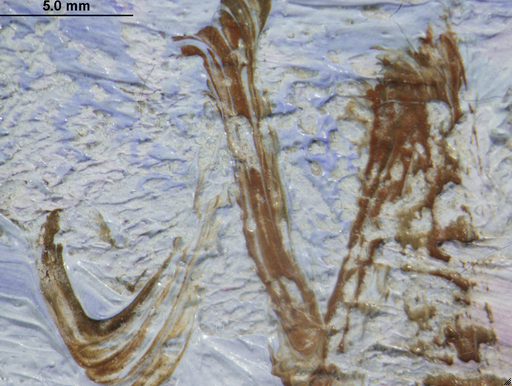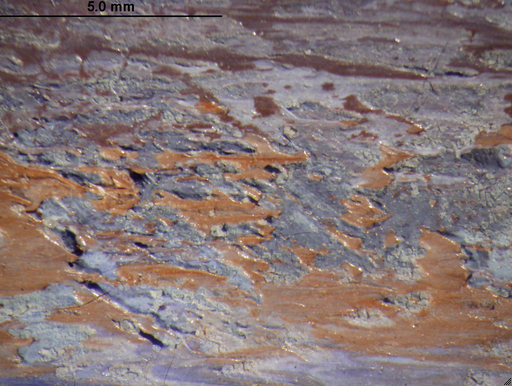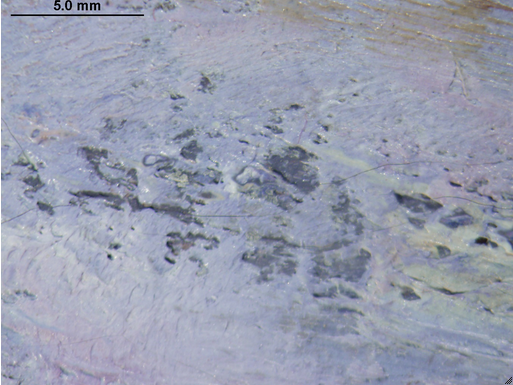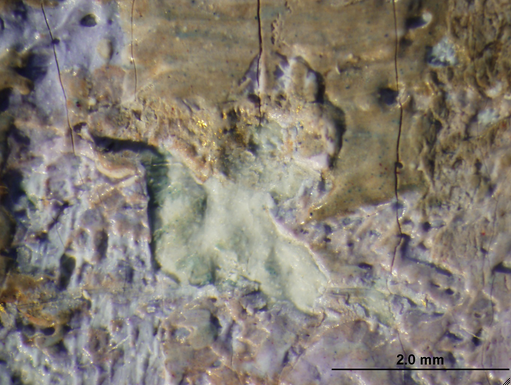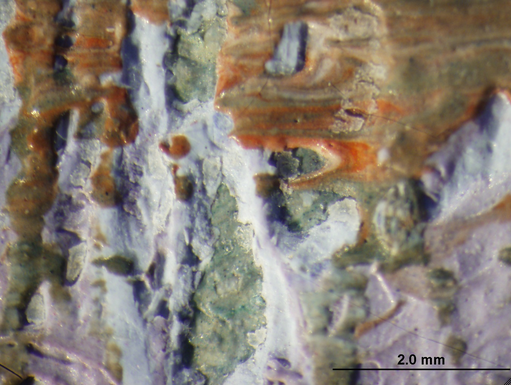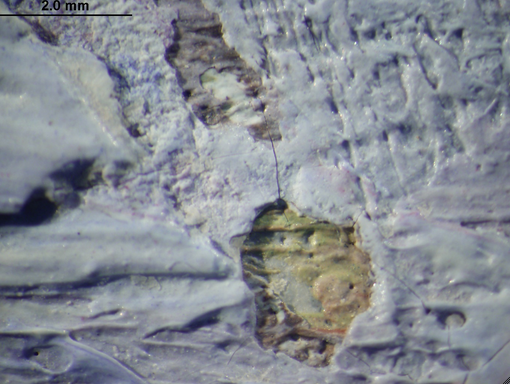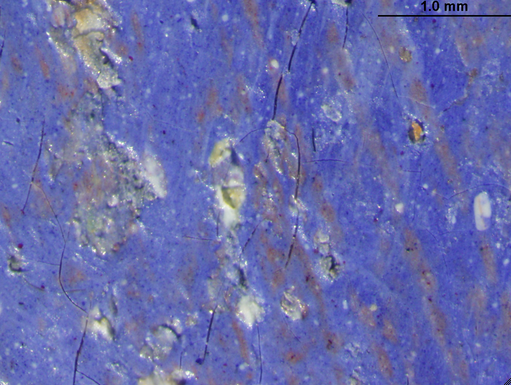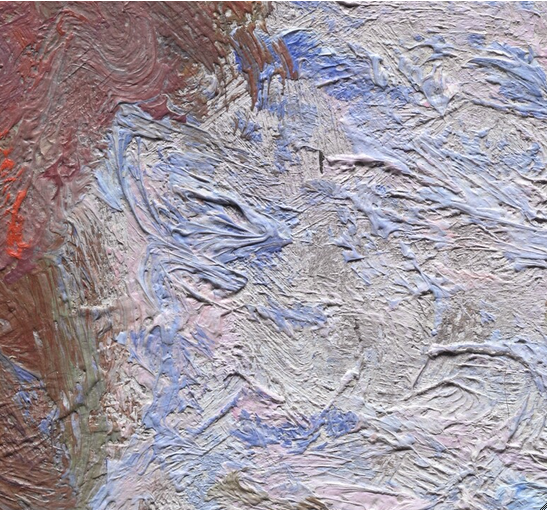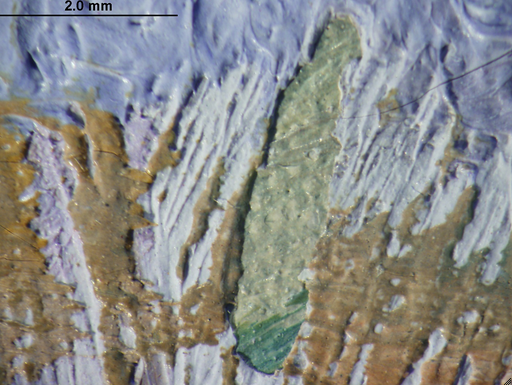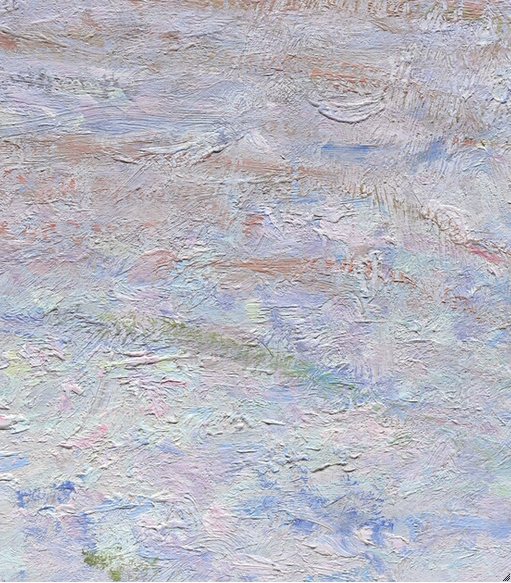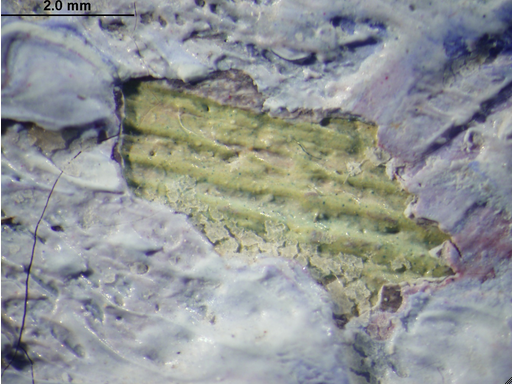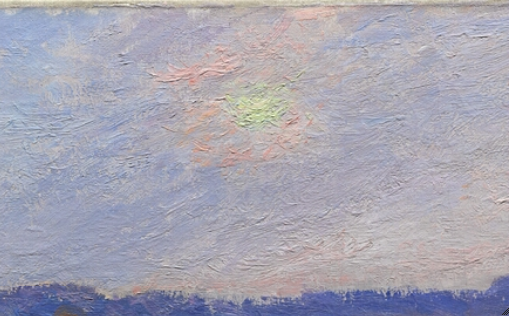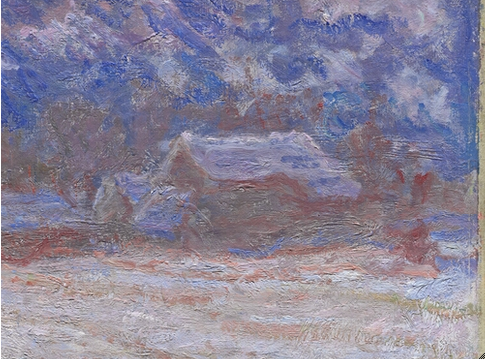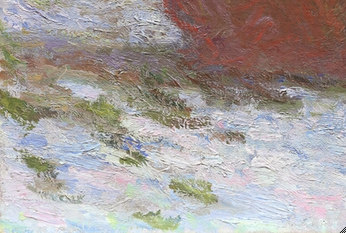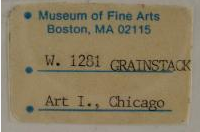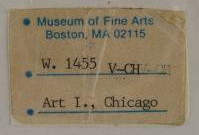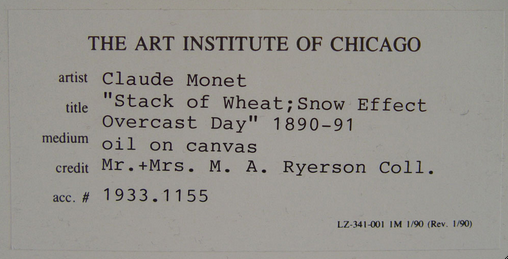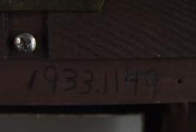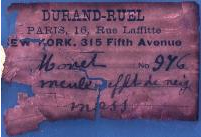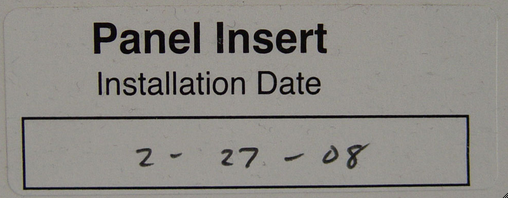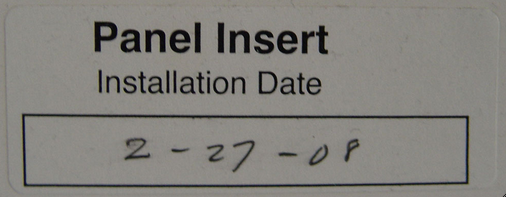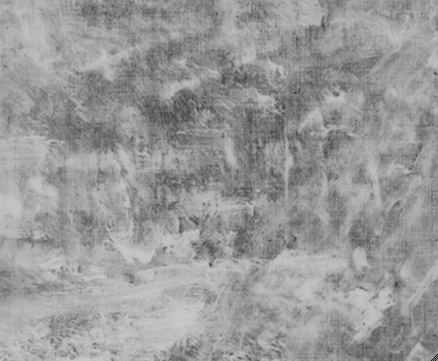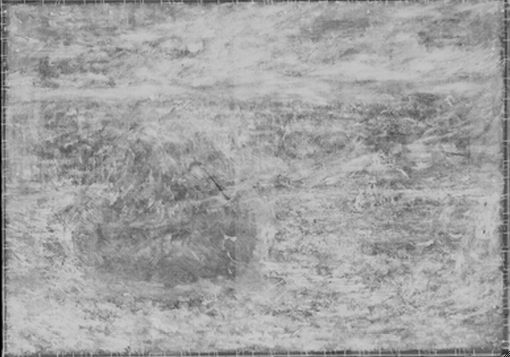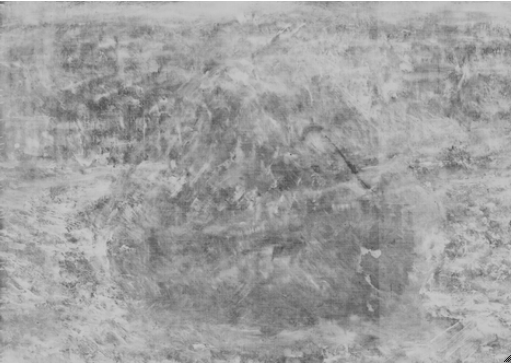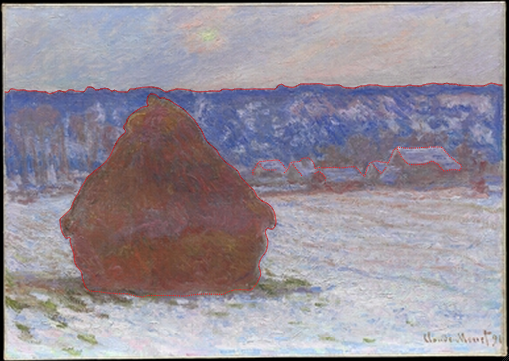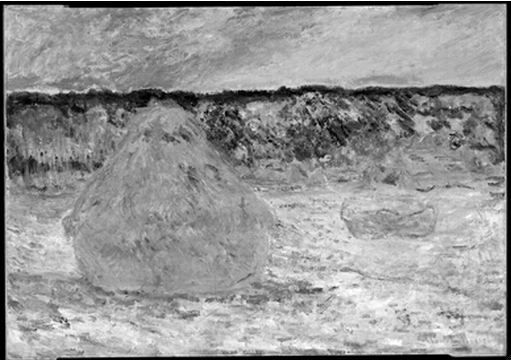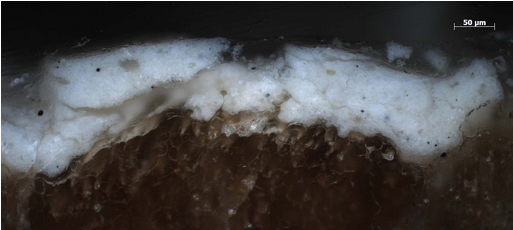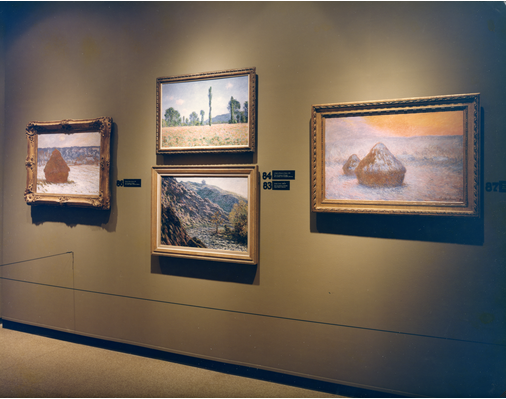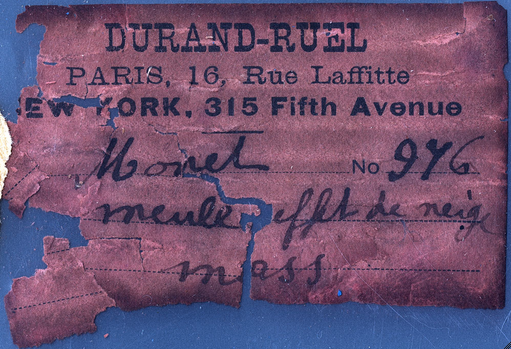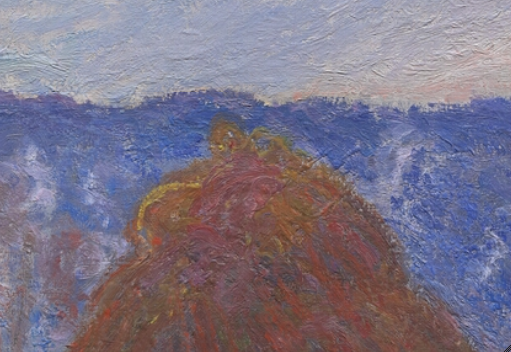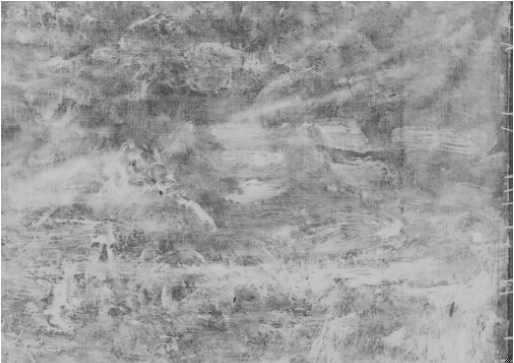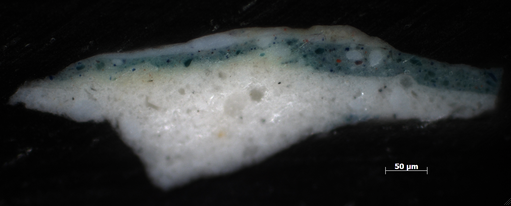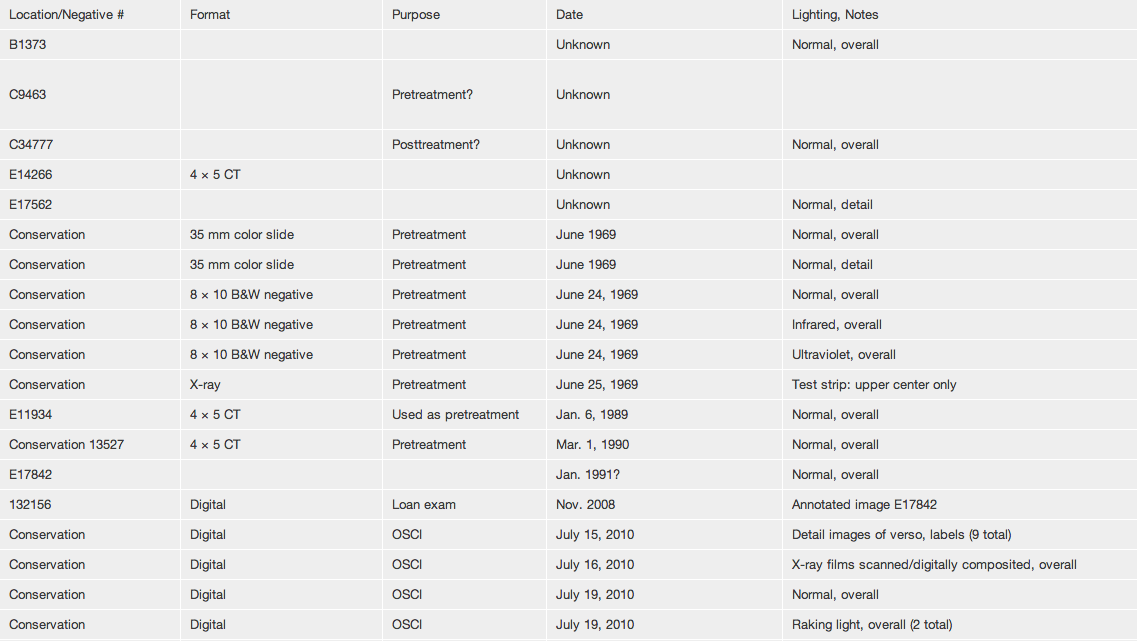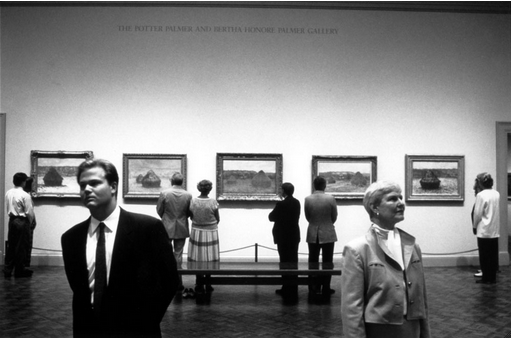Technical Report
Technical Summary
Claude Monet’s Stack of Wheat (Snow Effect, Overcast Day) was painted on a pre-primed, no. 30 landscape (paysage) standard-size linen canvas. The ground consists of a single, off-white layer. A warp-thread match was detected with two other Monet paintings from the Art Institute’s collection: The Customs House at Varengeville (cat. 35 [W1455], inv. 1933.1149) and Charing Cross Bridge, London (cat. 40 [W1527], inv. 1933.1150), suggesting that the fabric for these paintings came from the same bolt of material. The painting has a richly textured surface, which is largely related to the fact that the final painting was executed on top of an earlier composition, which included a second smaller stack on the right side of the canvas. Open brushwork and a few small areas of interlayer cleavage between the two compositions reveal that the field and at least part of the background hills of the earlier composition consisted predominantly of bright green tones, suggesting that the earlier painting may not have been a winter scene. The artist then covered the green field with a layer of lead white–rich paint. Where visible, it appears that a thin, dull-purple toning layer was applied over the white intermediate layer before the snow-covered field was painted. It appears that the final wheat stack was expanded on the left and right sides after the small stack was painted out of the composition. On the left side of the stack, brushwork unrelated to the final composition indicates the inclusion of one or more buildings in this area at an earlier stage of the painting. There are also brushstrokes that form a rough diagonal slope from around the middle of the final stack to the upper right edge of the painting. It is unclear whether these forms were associated with the earlier two-stack composition or whether they could be related to an even earlier composition.
Multilayer Interactive Image Viewer
The multilayer interactive image viewer is designed to facilitate the viewer’s exploration and comparison of the technical images (fig. 30.1).
Signature
Signed and dated: Claude Monet (lower right, in light reddish-brown paint) (fig. 30.2). Some of the underlying brushstrokes were still wet when the signature and date were applied, specifically, the pale blue strokes (fig. 30.3). Near the edges, these pale blue brushstrokes are directly over the ground layer and may represent final touches added to the corner just before the painting was signed.
Structure and Technique
Support
Canvas
Flax (commonly known as linen).
Standard format
The original dimensions were approximately 65 × 92 cm, which corresponds to a no. 30 landscape (paysage) standard-size stretcher.
Weave
Plain weave. Average thread count (standard deviation): 21.5V (0.8) × 23.4H (0.6) threads/cm; the horizontal threads were determined to correspond to the warp and the vertical threads to the weft. A warp-thread match was determined with two other Monet paintings: The Customs House at Varengeville (cat. 35 [W1455], inv. 1933.1149) and Charing Cross Bridge (cat. 40 [W1527], inv. 1933.1150).
Canvas characteristics
There is mild cusping along the bottom, left, and right edges, and more pronounced and irregular cusping along the top edge.
Stretching
Current stretching: Dates to the 1991 conservation treatment (see Conservation History) tacks spaced 3–4 cm apart, with paper interleaf.
Original stretching: Tack holes spaced 5–7 cm apart. Most of the holes correspond to the cusping pattern, except along the top edge where the cusping is more pronounced and the points of attachment seem to originate from beyond the cut edge of the canvas). There is a series of smaller pinholes around the edges, spaced approximately 3–4 cm apart (only present on the left side of the bottom edge, unless holes are present underneath the current tacks). The purpose and origin of these holes are not known.
Stretcher/strainer
Current stretcher: Dates to the 1991 conservation treatment (see Conservation History); five-membered wooden stretcher with vertical crossbar, butt-ended mortise and tenon joints, keyable (no keys inserted). Depth: 3 cm
Original stretcher: Discarded. The pre-1969-treatment stretcher may have been the original stretcher. It was described as having five members including a horizontal (probably vertical, as in drawing) crossbar. Depth: Not documented.
Manufacturer’s/supplier’s marks
None observed in current examination or documented in previous examinations.
Preparatory Layers
Sizing
Not determined (probably glue).
Ground application/texture
There is a ground layer that extends to the edges of all four tacking margins, indicating that the canvas was cut from a larger piece of primed fabric, which was probably commercially prepared. The ground ranges from approximately 20 to 120 µm in thickness (fig. 30.4). Numerous bubble holes were observed in the ground layer (fig. 30.5).
Color
The ground is off-white with some dark particles visible under magnification (fig. 30.6).
Materials/composition
Analysis indicates the presence of the following components: lead white and calcium carbonate (chalk), with traces of bone black, iron oxide, alumina, silica, and various silicates. Binder: Oil (estimated).
Compositional Planning/Underdrawing/Painted Sketch
Extent/character
No underdrawing was observed with infrared reflectography (IRR) or microscopic examination.
Paint Layer
Application/technique and artist’s revisions
The infrared reflectogram clearly shows that the artist originally included another smaller wheat stack on the right side of the painting. This stack was set farther back in the composition than the large stack in the final painting, and it extended up into the area currently occupied by the buildings (fig. 30.7). The painted-out stack is difficult to see in the X-ray and transmitted-infrared images, which may indicate that it was not built up very far. Breaks in the upper paint layers reveal dark blue-gray and brownish paint underneath, which may indicate the general tone of the stack, as far as it was developed (fig. 30.8, fig. 30.9, fig. 30.10).
Throughout the field, breaks in the brushwork and a few small losses in the upper paint layers resulting from interlayer cleavage provide glimpses of paint from the earlier composition and indicate that the painting originally had a different color scheme. Losses near the left, right, and bottom edges reveal bright green and yellowish-green paint layers underneath the snow-covered field (fig. 30.11, fig. 30.12, fig. 30.13). Similar bright green was observed in the layers underneath the buildings on the right side of the canvas. Other hues observed from the underlying painting (although not as prevalent as the green tones) include pale orange, pink, and gray as well as a very dark brown tone to the right of the stack in the final painting (fig. 30.14). The presence of these bright colors may indicate that the earlier composition was not a winter scene. An area of the green paint, exposed at a loss near the right edge (fig. 30.15), was analyzed with X-ray fluorescence spectroscopy (XRF) and was found to contain the copper-and-arsenic-containing pigment emerald green. This bright green was not detected in the upper layers of the painting. PLM analysis also detected emerald green in lower paint layers (fig. 30.16) but not in any other samples taken from representative areas of the final composition. These findings suggest that the pigment was used only in the earlier composition. A buildup of textural brushwork unrelated to the final composition appears to be associated with a thick, brushy application of lead white–rich paint in the foreground of the painting. Evidence of this layer is present to the right of the painted-out stack and in areas where the bright green underlayer is exposed (fig. 30.17). It does not, however, appear to be present underneath either the final or the painted-out stack. This may represent a kind of blocking-out layer that was aimed specifically at covering the bright green field of the earlier painting. Localized interlayer cleavage has occurred between the earlier composition and this intermediate layer, which appears to have been applied when the underlying painting was already surface dry, probably resulting in poor adhesion. Where the intermediate layer is visible at the edges of losses, it appears to be covered with a thin, dull purplish-gray layer, which seems to serve as a toning layer for the final composition (fig. 30.18, fig. 30.19, fig. 30.20). The edges of the paint losses often look quite soft, as if the paint was still somewhat fluid when the losses occurred. In at least one place—a small loss near the lower right corner—a later brushstroke curves over the edges of the paint loss, suggesting that the loss occurred while the artist was still working on the painting (fig. 30.21).
In the background area, at the left edge of the large stack, a series of distinct linear brushmarks, visible in the X-ray and transmitted-infrared (IR) images, seems to indicate that the artist originally painted some architectural forms in this location (fig. 30.22). Other brushwork unrelated to the final composition includes a series of radio-opaque strokes that form a diagonal, running from approximately the center of the final stack to the upper-right edge of the painting (fig. 30.23). It is unclear whether these forms were associated with the earlier composition that included the smaller stack or whether they may have been part of an even earlier composition.
In the process of painting the final composition, some modifications were made to the large wheat stack. The X-ray indicates that the stack was originally significantly smaller, possibly with its peak positioned further to the right (fig. 30.24). It was then subsequently expanded along the left and right sides. The stack appears to have been planned from early on in the painting of the final composition, and it is possible that it coexisted (in its earlier, smaller incarnation) with the small, painted-out stack at some point. The smaller dimensions of the stack were in place in the final composition, when the snowy landscape in the distance was painted around it, including the hills, trees, and buildings, which were added on top of the painted-out stack. The blue hills and the screen of trees behind the final stack can be seen to continue underneath the edges of the stack up to its original borders in the X-ray and detail images (fig. 30.24, fig. 30.25). On the right side of the painting, brushstrokes that do not correspond to the final composition seem to indicate that some adjustments were made to the buildings: the roof of the building farthest to the right appears to have originally extended further to the right, and a strong horizontal stroke near the right edge may have been related to another building that was ultimately not included in the final composition (fig. 30.26). The paint of the sky is quite thickly built up, making it difficult to see the underlying layers (fig. 30.27). Most of the surface consists of a fairly continuous wet-in-wet paint application.
Overall, the paint layer has a rich, textural surface, with thick brush-marked strokes and areas of low impasto, the texture coming from the two superimposed compositions as well as the intermediate layer applied to much of the foreground (fig. 30.28). For the most part, the paint has a relatively dry, stiff, paste-like consistency, with a predominantly matte surface finish. Some areas, such as the expanded left edge of the stack, appear more fluid with wet-in-wet paint application, the brushstrokes of which have settled out to some degree, resulting in a slightly smoother surface and suggesting that the artist added extra medium to the paint (fig. 30.29). Some of the final touches added to the painting include the reddish-brown trees in the background (fig. 30.30) and the colored diagonal strokes applied over the surface of the snow, which consist largely of dry brushstrokes that deposited mainly on the high points of the underlying paint texture (fig. 30.31). A deep ridge along the right edge of the painting seems to have occurred when the paint was still soft and may be related to framing or some kind of transport device (fig. 30.32).
Painting tools
Brushes including 1.0 cm width, flat ferrule (based on width and shape of brushstrokes). A few brush hairs are embedded in the paint surface.
Palette
Analysis indicates the presence of the following pigments: lead white, cadmium yellow, chrome yellow, vermilion, red lake, viridian, emerald green, cobalt blue, and ultramarine blue. UV fluorescence indicates the liberal use of red lake throughout the landscape (fig. 30.33).
Binding media
Oil (estimated).
Surface Finish
Varnish layer/media
The painting was cleaned in 1991 and selectively varnished with dilute Arkon-P90 to saturate areas of localized blanching in the wheat stack only (see ). The paint surface has a relatively dry, matte quality in most areas. It is noted in the conservation file that a natural-resin varnish (estimated) was removed in 1969; the origin of that varnish is not known.
Conservation History
In 1969, yellowed varnish and overpaint were removed. The painting was wax-resin lined and restretched on an ICA spring stretcher. A layer of polyvinyl acetate (PVA) AYAA was applied. Inpainting was carried out. A layer of methacrylate resin L-46 was applied, followed by a layer of AYAA.
In 1991, the AYAA and methacrylate varnish layers applied in 1969 were removed. Residues of starch-paste adhesive from the 1969 treatment were removed mechanically after the residues had been dampened. The wax-resin lining was removed. The canvas was edge lined and mounted on a tongue and groove stretcher prepared with a loose lining. Selective revarnishing of the wheat stack was carried out with dilute Arkon-P90, in order to minimize the effects of localized blanching after the varnish removal. Minor scattered inpainting was carried out.
Condition Summary
The painting is in good condition. The canvas was edge lined and loose lined in 1991 after removal of the wax-resin lining that had been applied in 1969. The canvas is stretched flat and taut on the stretcher. There is some loss and abrasion in the ground layer on the original tacking margins. The paint layer has a rich, textural surface. A few small areas of interlayer cleavage in the field and the sky appear to be old and seem to be due to poor adhesion between the upper paint layers and the earlier composition. There is localized retouching associated with some of these losses. There is some flattening of thicker paint and dark accretions around the edges, which appear to be the result of framing while the paint was still soft. There is a general network of age cracks; this is most noticeable in the sky, which has a slightly quilted appearance. In addition, there are fine, slightly opened drying cracks in the upper layers of the wheat stack, revealing light-colored paint beneath. There are some starch-paste residues in the recesses of the paint texture. The painting is currently unvarnished, except for the localized application of Arkon P-90 on the upper part of the stack, which was applied to deal with blanching issues. Overall, the paint surface is relatively matte, with some slight variations in sheen across the surface.
Kimberley Muir
Frame
Current frame (installed in 1995: this frame was originally on The Customs House at Varengeville [transferred in 1995] (cat. 35): The frame is not original to the painting. It is a French (Parisian), late-nineteenth-century, Durand-Ruel Régence, ogee frame with cast foliate and center cartouches and fillet liner. The frame is both water and oil gilded. Red-brown bole was used on the perimeter, cast foliate ornament on the face and sight molding, and the liner. Red bole was used for the scotia sides. The gilding was applied directly to the plaster on the ogee face in the crosshatched areas between the ornament. The quadrillage face has been rubbed to bring out the white of the plaster. The frame has an overall bronze tone with casein or gouache raw umber and gray washes. The frame has a glued pine substrate with a cast plaster face. At a later date the original back of the frame was planed flat, removing all construction history and provenance. A back frame was then glued to the back. All back and interior surfaces have been overpainted. The molding, from perimeter to interior, is fillet with stylized cast dovetail-pierced egg-and-flower molding; scotia side; ogee face with a cast quadrillage bed and center and corner foliate and floral cartouches with cabochon centers on a double-lined diamond bed with punched centers; fillet; sanded front frieze; fillet; ogee with stylized leaf-tip-and-shell sight molding; and independent fillet liner with cove sight (fig. 30.34).
Previous frame (installed by 1975; removed 1995) The work was previously housed in a twentieth-century reproduction of a Régence frame with swept sides and foliate rocaille cartouches (fig. 30.35, fig. 30.36).
Kirk Vuillemot
Exhibition History
Paris, Galeries Durand-Ruel, Exposition d’oeuvres récentes de Claude Monet, May 1891, cat. 9, as Meule. (Effet de neige; temps couvert), Appartient à M. Durand-Ruel.
Minneapolis Institute of Arts, Inaugural Exhibition, Jan. 7–Feb. 7, 1915, cat. 255, as The Haystack, Lent by Martin A. Ryerson, Chicago, Ill.
Art Institute of Chicago, “A Century of Progress”: Loan Exhibition of Paintings and Sculpture for 1934, June 1–Oct. 31, 1934, cat. 218.
Decatur (Ill.) Art Center, Masterpieces of European and American Art Lent by the Art Institute of Chicago, Mar. 4–25, 1945, cat. 12; Springfield (Ill.) Art Association, Apr. 1945, no cat.
Chicago, Remington Rand, window display, Apr. 14–30, 1952, no cat.
University of Chicago, Lexington Hall, Nov. 17–Dec. 17, 1952, no cat.
Park Forest (Ill.) Art Center, Mar. 25–Apr. 22, 1956, no cat.
Art Institute of Chicago, The Paintings of Claude Monet, Apr. 1–June 15, 1957, no cat. no.
Art Institute of Chicago, Paintings by Monet, Mar. 15–May 11, 1975, cat. 86 (ill.). (fig. 30.37)
Los Angeles County Museum of Art, A Day in the Country: Impressionism and the French Landscape, June 28–Sept. 16, 1984, cat. 111 (ill.); Art Institute of Chicago, Oct. 23, 1984–Jan. 6, 1985; Paris, Galeries Nationales d’Exposition, Grand Palais, as L’impressionnisme et le paysage français, Feb. 4–Apr. 22, 1985.
Leningrad (now Saint Petersburg), State Hermitage Museum, Ot Delakrua do Matissa: Shedevry frantsuzskoi zhivopisi XIX–nachala XX veka, iz Muzeia Metropoliten v N’iu-Iorke i Khudozhestvennogo Instituta v Chikago [From Delacroix to Matisse: Masterpieces of French Painting of the Nineteenth to the Beginning of the Twentieth Century from the Metropolitan Museum of Art, New York, and the Art Institute of Chicago], Mar. 15–May 16, 1988, cat. 30 (ill.); Moscow, Pushkin State Museum of Fine Arts, May 30–July 30, 1988.
Boston, Museum of Fine Arts, Monet in the ’90s: The Series Paintings, Feb. 7–Apr. 29, 1990, cat. 25 (ill.); Chicago, Art Institute of Chicago, May 19–Aug. 12, 1990; and London, Royal Academy of Arts, Sept. 7–Dec. 9, 1990. (fig. 30.38)
Art Institute of Chicago, Claude Monet, 1840–1926, July 22–Nov. 26, 1995, cat. 99 (ill.) (fig. 30.39)
Washington, D.C., Phillips Collection, Impressionists in Winter: Effets de neige, Sept. 19, 1998–Jan. 3, 1999, cat. 23 (ill.); San Francisco, Fine Arts Museums of San Francisco at the Center for the Arts at Yerba Buena Gardens, Jan. 30–May 2, 1999 (Washington only).
Hamburg, Hamburger Kunsthalle, Monets Vermächtnis: Serie—Ordnung und Obsession, Sept. 28, 2001–Jan. 6, 2002, no cat. no. (ill.).
Fort Worth, Tex., Kimbell Museum of Art, The Impressionists: Master Paintings from the Art Institute of Chicago, June 29–Nov. 2, 2008, cat. 78 (ill.).
Selected References
Galeries Durand-Ruel, Exposition Claude Monet, exh. cat. (Galeries Durand-Ruel, 1891), p. 15, cat. 9.
Minneapolis Institute of Arts, Catalogue of the Inaugural Exhibition, exh. cat. (Minneapolis Society of Fine Arts, 1915), p. 44, cat. 255.
Gustave Geffroy, Claude Monet: Sa vie, son temps, son oeuvre (G. Crès, 1922), p. 189.
Art Institute of Chicago, “Accessions and Loans,” Bulletin of the Art Institute of Chicago 16, 3 (May 1922), p. 47.
M. C., “Monets in the Art Institute,” Bulletin of the Art Institute of Chicago 19, 2 (Feb. 1925), p. 20.
Art Institute of Chicago, Catalogue of “A Century of Progress”: Exhibition of Paintings and Sculpture, 1934, ed. Daniel Catton Rich, exh. cat. (Art Institute of Chicago, 1934), p. 37, cat. 218.
George Slocombe, “Giver of Light,” Coronet 3, 5 (Mar. 1938), p. 23 (ill.).
“Critics of Art Hear Lecture by Dr. Neal,” Decaturian Weekly 42, 12 (Mar. 16, 1945), p. 1.
Decatur Art Center, Masterpieces of European and American Art Lent by the Art Institute of Chicago, exh. cat. (Decatur Art Center, 1945), p. 7, cat. 12.
Oscar Reuterswärd, Monet: En konstnärshistorik (Bonniers, 1948), p. 286.
Art Institute of Chicago, “Catalogue,” Art Institute of Chicago Quarterly 51, 2 (Apr. 1, 1957), p. 33.
Art Institute of Chicago, Paintings in the Art Institute of Chicago: A Catalogue of the Picture Collection (Art Institute of Chicago, 1961), p. 320.
J. Patrice Marandel, “Monet in Chicago,” Art Gallery Magazine 18, 6 (Mar. 1975), p. 48 (ill.).
Susan Wise, ed., Paintings by Monet, exh. cat. (Art Institute of Chicago, 1975), pp. 50, pl. 6; 143, cat. 86 (ill.).
Daniel Wildenstein, Claude Monet: Biographie et catalogue raisonné, vol. 3, Peintures, 1887–1898 (Bibliothèque des Arts, 1979), pp. 38; 42, n. 1032; 142; 143, cat. 1281 (ill.).
Robert Gordon and Andrew Forge, Monet (Abrams, 1983), pp. 160 (ill.), 163, 292.
Andrea P. A. Belloli, ed., A Day in the Country: Impressionism and the French Landscape, exh. cat. (Los Angeles County Museum of Art, 1984), p. 365.
Richard R. Brettell, “Monet’s Haystacks Reconsidered,” Art Institute of Chicago Museum Studies 11, 1 (Autumn 1984), pp. 6; 7; 12; 13, pl. 5; 16–17, fig. 9 (ill.); 21, n. 6, n. 7.
Richard R. Brettell, “The Fields of France,” in A Day in the Country: Impressionism and the French Landscape, ed. Andrea P. A. Belloli, exh. cat. (Los Angeles County Museum of Art, 1984), pp. 246; 260; 270, no. 111 (ill.).
Richard R. Brettell, “La campagne française,” in L’impressionnisme et le paysage français, exh. cat. (Réunion des Musées Nationaux, 1985), pp. 261; 282; 290, no. 111 (ill.).
Richard R. Brettell and Scott Schaefer, “Impressionism in Context,” in A Day in the Country: Impressionism and the French Landscape, ed. Andrea P. A. Belloli, exh. cat. (Los Angeles County Museum of Art, 1984), pp. 19, 21, 22.
Richard R. Brettell and Scott Schaefer, introduction to L’impressionnisme et le paysage français, exh. cat. (Réunion des Musées Nationaux, 1985), pp. 17, 18, 19.
Sylvie Gache-Patin and Scott Schaefer, “Impressionism and the Sea,” in A Day in the Country: Impressionism and the French Landscape, ed. Andrea P. A. Belloli, exh. cat. (Los Angeles County Museum of Art, 1984), p. 284.
Sylvie Gache-Patin and Scott Schaefer, “La mer,” in L’impressionnisme et le paysage français, exh. cat. (Réunion des Musées Nationaux, 1985), p. 304.
Françoise Heilbrun, “Appendix: The Landscape in French Nineteenth-Century Photography,” in A Day in the Country: Impressionism and the French Landscape, ed. Andrea P. A. Belloli, exh. cat. (Los Angeles County Museum of Art, 1984), p. 359.
Françoise Heilbrun, “Le paysage dans la photographie française au XIXe siècle et ses rapports avec la peinture du realisme à l’impressionnisme,” in L’impressionnisme et le paysage français, exh. cat. (Réunion des Musées Nationaux, 1985), p. 384.
Scott Schaefer, “The Retreat from Paris,” in A Day in the Country: Impressionism and the French Landscape, ed. Andrea P. A. Belloli, exh. cat. (Los Angeles County Museum of Art, 1984), p. 305.
Scott Schaefer, “L’évasion loin de Paris,” in L’impressionnisme et le paysage français, exh. cat. (Réunion des Musées Nationaux, 1985), p. 328.
John House, “Monet and the Genesis of His Series,” in Auckland City Art Gallery, Claude Monet: Painter of Light, exh. cat. (Auckland City Art Gallery/NZI , 1985), pp. 19; 21, fig. 11.
Charles F. Stuckey, ed., Monet: A Retrospective (Hugh Lauter Levin, 1985), p. 163 (ill.).
Richard Shiff, “The End of Impressionism,” in The New Painting: Impressionism, 1874–1886, ed. Charles S. Moffett, exh. cat. (Fine Arts Museums of San Francisco, 1986), pp. 64; 66, fig. 5.
Ministry of Culture, SSSR; State Hermitage Museum; Pushkin State Museum of Fine Arts; Metropolitan Museum of Art, New York; and Art Institute of Chicago, Ot Delakrua do Matissa: Shedevry frantsuzskoi zhivopisi XIX–nachala XX veka, iz Muzeia Metropoliten v N’iu-Iorke i Khudozhestvennogo Instituta v Chikago [From Delacroix to Matisse: Masterpieces of French Painting of the Nineteenth to the Beginning of the Twentieth Century from the Metropolitan Museum of Art, New York, and the Art Institute of Chicago], trans. from English by Iu. A. Kleiner and A. A. Zhukov, exh. cat. (Avrora, 1988), pp. 82–83, cat. 30 (ill.).
Grace Seiberling, Monet in London, exh. cat. (High Museum of Art/University of Washington Press, 1988), p. 10 (ill.).
Richard Kendall, ed., Monet by Himself: Paintings, Drawings, Pastels, Letters, trans. Bridget Strevens Romer (Macdonald Orbis, 1989), p. 203 (ill.); 320.
Paul Hayes Tucker, Monet in the ’90s: The Series Paintings, exh. cat. (Museum of Fine Arts, Boston/Yale University Press, 1989), pp. 3; 77; 80; 82, pl. 24; 296, cat. 25.
Karin Sagner-Düchting, Claude Monet, 1840–1926: Ein Fest für die Augen (Benedikt Taschen Verlag, 1990), pp. 161–62 (ill.), 170. Translated by Karen Williams Wall,Claude Monet 1840-1926: A Feast for the Eyes (Taschen, 2004), pp. 161–62 (ill.).
Sylvie Patin, Monet: “Un oeil . . . mais, bon Dieu, quel oeil!” (Gallimard/Réunion des Musées Nationaux, 1991), pp. 106–07 (ill.), 172. Translated by Anthony Roberts as Monet: The Ultimate Impressionist (Abrams, 1993), pp. 106–07 (ill.); 171.
Anne Rorimer, “The Date Paintings of On Kawara,” Art Institute of Chicago Museum Studies 17, 2 (1991), p. 122, fig. 2.
John Sallis, “Monet’s Grainstacks: Shades of Time,” Tema Celeste International Art Magazine 30 (Mar.–Apr. 1991), pp. 63; 64 (ill.); 67, nn. 3, 13.
Gérald Collot, “Blanc comme neige. . .” in Couleurs de neige, exh. cat. (Musée Savoisien/Skira, 1992), p. 16 (ill.).
Sophie Fourny-Dargère, Monet, Profils de l’art (Chêne, 1992), p. 118, fig. 2.
Christoph Heinrich, Claude Monet, 1840–1926 (Benedikt Taschen, 1993), pp. 55, 58 (ill.), 95.
Andrew Forge, Monet, Artists in Focus (Art Institute of Chicago, 1995), pp. 44; 89, pl. 18; 108.
Charles F. Stuckey, with the assistance of Sophia Shaw, Claude Monet, 1840–1926, exh. cat. (Art Institute of Chicago/Thames & Hudson, 1995), p. 120, cat. 99 (ill.); 220.
Daniel Wildenstein, Monet, or The Triumph of Impressionism, cat. rais., vol. 1 (Taschen/Wildenstein Institute, 1996), pp. 274, cat. 1281 (ill.); 275.
Daniel Wildenstein, Monet: Catalogue raisonné/Werkverzeichnis, vol. 3, Nos. 969–1595 (Taschen/Wildenstein Institute, 1996), pp. 494, cat. 1281 (ill.); 500.
David Spence, Monet: Impressionism (Ticktock, 1997), p. 27.
Matthias Arnold, Claude Monet, Rowohlts Monographien (Rowohlt, 1998), p. 133 (ill.).
Charles S. Moffett, “Effet de neige: ‘Claude Monet and a Few Others. . . ,’” in Charles S. Moffett, Eliza E. Rathbone, Katherine Rothkopf, and Joel Isaacson, Impressionists in Winter: Effets de neige, exh. cat. (Phillips Collection/Philip Wilson, 1998), pp. 20, 22.
Charles S. Moffett, Eliza E. Rathbone, Katherine Rothkopf, and Joel Isaacson, Impressionists in Winter: Effets de neige, exh. cat. (Phillips Collection/Philip Wilson, 1998), pp. 79; 210–11, cat. 23.
Eliza E. Rathbone, “Road by Saint-Siméon Farm in Winter,” in Charles S. Moffett, Eliza E. Rathbone, Katherine Rothkopf, and Joel Isaacson, Impressionists in Winter: Effets de neige, exh. cat. (Phillips Collection/Philip Wilson, 1998), p. 82.
Katherine Rothkopf, “Rue Eugène Moussoir at Moret: Winter,” in Charles S. Moffett, Eliza E. Rathbone, Katherine Rothkopf, and Joel Isaacson, Impressionists in Winter: Effets de neige, exh. cat. (Phillips Collection/Philip Wilson, 1998), p. 188.
Katherine Rothkopf, “Stacks of Wheat (Snow Effect, Overcast Day); Stack of Wheat; Grainstacks: Snow Effect; Stacks of Wheat (Sunset, Snow Effect),” in Charles S. Moffett, Eliza E. Rathbone, Katherine Rothkopf, and Joel Isaacson, Impressionists in Winter: Effets de neige, exh. cat. (Phillips Collection/Philip Wilson, 1998), pp. 120; 121, cat. 23 (ill.); 122.
John Sallis, Shades—Of Painting at the Limit (Indiana University Press, 1998), pl. 6; 26, n. 13; 48.
Art Institute of Chicago, Impressionism and Post-Impressionism in the Art Institute of Chicago, selected by James N. Wood (Art Institute of Chicago/Hudson Hills, 2000), p. 133 (ill.).
Christoph Heinrich, “Une série d’effets différents: Monets ‘Getreideschober’ als Hülle für das Licht, die Zeit, das Universum—und ‘die märchenhafte Kraft und Pracht der Malerei,’” in Monets Vermächtnis: Serie—Ordnung und Obsession, ed. Christoph Heinrich, exh. cat. (Hamburger Kunsthalle/Hatje Cantz, 2001), p. 17.
Christoph Heinrich, ed., Monets Vermächtnis: Serie—Ordnung und Obsession, exh. cat. (Hamburger Kunsthalle/Hatje Cantz, 2001), pp. 62 (ill.), 183.
Richard R. Brettell, From Monet to Van Gogh: A History of Impressionism, vol. 2 (Teaching Co., 2002), pp. 161, 167, 183.
Anna Gruetzner Robins, “‘Slabs of Pink and Lumps of Brown’: The Critical Reaction to the Exhibition of a Monet Grainstack Painting in Britain in 1893,” in Monet and French Landscape: Vétheuil and Normandy, ed. Frances Fowle (National Galleries of Scotland, 2006), pp. 159; 168, n. 10, n. 11.
Charles F. Stuckey, “The Predications and Implications of Monet’s Series,” in The Repeating Image: Multiples in French Painting from David to Matisse, ed. Eik Kahng, exh. cat. (Walters Art Museum/Yale University Press, 2007), pp. 85; 87–88, fig. 9.
Eric M. Zafran, “Monet in America,” in Wildenstein and Co., Claude Monet (1840–1926): A Tribute to Daniel Wildenstein and Katia Granoff, exh. cat. (Wildenstein, 2007), p. 112; 143, fig. 62b.
Gloria Groom and Douglas Druick, with the assistance of Dorota Chudzicka and Jill Shaw, The Impressionists: Master Paintings from the Art Institute of Chicago, exh. cat. (Art Institute of Chicago/Kimbell Art Museum, 2008), pp. 22; 103; 108; 156; 158, cat. 78 (ill.). Simultaneously published as Gloria Groom and Douglas Druick, with the assistance of Dorota Chudzicka and Jill Shaw, The Age of Impressionism at the Art Institute of Chicago (Art Institute of Chicago/Yale University Press, 2008), pp. 22; 103; 108; 156; 158, cat. 78 (ill.).
Félicie de Maupeou, “Esthétique et littérature artistique,” under the direction of Ségolène Le Men, La bibliothèque de Monet, exh. cat. (Citadelles & Mazenod, 2013), pp. 106–07 (ill.).
Other Documentation
Documentation from the Durand-Ruel Archives
Inventory number
Stock Durand-Ruel Paris 942
Durand-Ruel, Paris, stock book 1891–1901
Inventory number
Stock Durand-Ruel New York 976
Durand-Ruel, New York, stock book 1888–93
Photograph number
Photo Durand-Ruel Paris 219
Other Documents
Label (fig. 30.40)
Purchase receipt, April 12, 1893
Labels and Inscriptions
Undated
Number
Location: frame
Method: handwritten script
Content: 1933.1149 [in ink with 55 written over 49 in pencil] (fig. 30.41)
Pre-1980
Label
Location: pre-1969-treatment stretcher (discarded); preserved in conservation file
Method: printed label with handwritten script
Content: DURAND-RUEL / PARIS, 16, Rue Laffitte / NEW YORK, 315 Fifth Avenue / Monet No9[7?]6 / meule effet de neige / mass (fig. 30.42)
Post-1980
Label
Location: backing board
Method: printed label with typewritten script
Content: Museum of Fine Arts / Boston, MA 02115 / W. 1281 GRAINSTACK / Art I., Chicago (fig. 30.43)
Label
Location: backing board
Method: printed label with typewritten script
Content: Museum of Fine Arts / Boston, MA 02115 / W. 1455 V-CH / Art I., Chicago (fig. 30.44)
Label
Location: backing board
Method: printed label
Content: THE ART INSTITUTE OF CHICAGO / artist Claude Monet / title “Stack of Wheat; Snow Effect / Overcast Day” 1890–91 / medium oil on canvas / credit: Mr.+Mrs. M. A. Ryerson Coll. / acc. # 1933.1155 / LZ-341-001 1M 1/90 (Rev. 1/90) (fig. 30.45)
Label
Location: backing board
Method: printed label
Content: MONET IN THE ’90s: / THE SERIES PAINTINGS / Museum of Fine Arts, Boston / Feb 7–Apr 29, 1990 / Art Institute of Chicago / May 19–Aug 12, 1990 / Royal Academy, London / Sep 7–Dec 9, 1990 / CAT# : 25 W: 1281 / TITLE : Grainstack (Snow effect; overcast day) / LENDER: The Art Institute of Chicago (fig. 30.46)
Label
Location: backing board
Method: printed label
Content: The Art Institute of Chicago / “Claude Monet: 1840–1926” / July 14, 1995–November 26, 1995 / Catalog: 99 / Wheatstack (Snow Effect, Overcast Day) / Meule, effet de neige, temps couvert / The Art Institute of Chicago, Mr. and Mrs. Martin A. / Ryerson Collection (1933.1155) (fig. 30.47)
Label
Location: backing board
Method: printed label with handwritten script
Content: Panel Insert / Installation Date / 2-27-08 (fig. 30.48)
Label
Location: backing board
Method: printed label with handwritten script
Content: Panel Insert / Installation Date / 2-27-08 (fig. 30.49)
Examination and Analysis Techniques
X-radiography
Westinghouse X-ray unit, scanned on Epson Expressions 10000XL flatbed scanner. Scans digitally composited by Robert G. Erdmann, University of Arizona.
Infrared Reflectography
Surface Optics modified near-infrared hyperspectral camera (collects 4 nm spectral-band images from 960 to 1730 nm); Goodrich/Sensors Unlimited SU640SDV-1.7RT with H filter (1.1–1.4 µm) and J filter (1.5–1.7 µm); Inframetrics Infracam with 1.5–1.73 µm filter; Fujifilm S5 Pro with X-Nite 1000B/2 mm filter (1.0–1.1 µm).
Transmitted Infrared
Fujifilm Pro with X-Nite 1000B/2 mm filter (1.0–1.1µm).
Visible Light
Natural-light, raking-light, and transmitted-light overalls and macrophotography: Fujifilm S5 Pro with X-NiteCC1 filter.
Ultraviolet
Fujifilm S5 Pro with X-NiteCC1 filter and Kodak Wratten 2E filter.
High-Resolution Visible Light (and Ultraviolet)
Sinar P3 camera with Sinarback eVolution 75 H (PECA 918 UV/IR interference cut filter and Kodak Wratten 2E filter).
Microscopy and Photomicrographs
Sample and cross-sectional analysis using a Zeiss Axioplan 2 research microscope equipped with reflected light/UV fluorescence and a Zeiss AxioCam MRc5 digital camera. Types of illumination used: darkfield, differential interference contrast (DIC), and UV. In situ photomicrographs with a Wild Heerbrugg M7A StereoZoom microscope fitted with an Olympus DP71 microscope digital camera.
X-ray Fluorescence Spectroscopy (XRF)
Several spots on the painting were analyzed in situ with a Bruker/Keymaster TRACeR III-V with rhodium tube.
Polarized Light Microscopy (PLM)
Zeiss Universal research microscope.
Scanning Electron Microscopy/Energy-Dispersive X-ray Spectroscopy (SEM/EDX)
Cross sections analyzed after carbon coating with a Hitachi S-3400N-II VP-SEM with an Oxford EDS and a Hitachi solid-state BSE detector. Analysis was performed at the Northwestern University Atomic and Nanoscale Characterization Experimental Center (NUANCE), Electron Probe Instrumentation Center (EPIC) facility.
Automated Thread Counting
Thread count and weave information were determined by Thread Count Automation Project software.
Image Registration Software
Overlay images registered using a novel image-based algorithm developed by Damon M. Conover (GW), John K. Delaney (GW, NGA), and Murray H. Loew (GW) of the George Washington University’s School of Engineering and Applied Science and the National Gallery of Art, Washington, D.C.
Image Inventory
The image inventory compiles records of all known images of the artwork on file in the Conservation Department, the Imaging Department, and the Department of Medieval to Modern European Painting and Sculpture at the Art Institute of Chicago (fig. 30.50).
